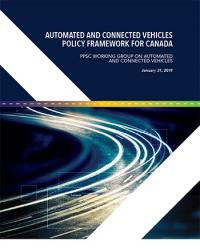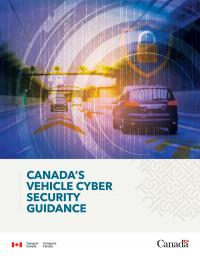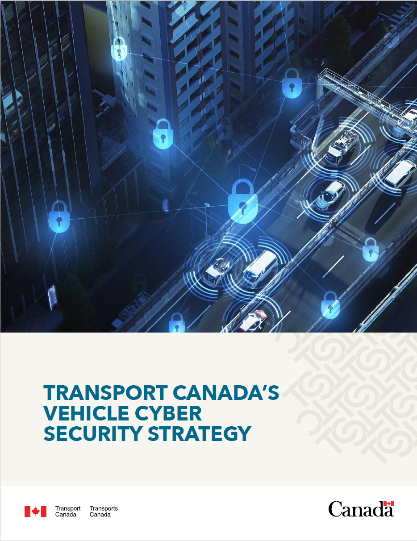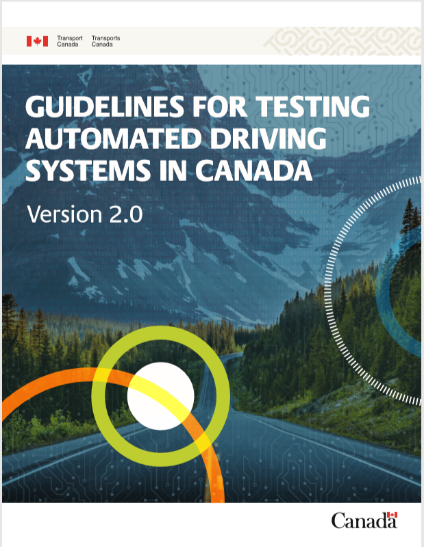The Government of Canada supports the safe testing and use of connected and automated vehicles. This page includes information on how each level of government contributes to road safety and resources to help companies develop connected and automated vehicle technologies in Canada.
On this page
- Federal, provincial or territorial, and municipal responsibilities
- Safety resources for connected and automated vehicles
- National Policy Framework on Connected and Automated Vehicles
- Canada's Safety Framework for Connected and Automated Vehicles 2.0
- Canada's Vehicle Cyber Security Guidance
- Transport Canada's Vehicle Cyber Security Strategy
- Canada's Vehicle Cyber Security Assessment Tool (VCAT)
- Safety Assessment for Automated Driving Systems in Canada
- Guidelines for Testing Automated Driving Systems in Canada Version 2.0
- Canadian Jurisdictional Guidelines for the Safe Testing and Deployment of Highly Automated Vehicles
- Ask for an exemption for a connected or automated vehicle
- Import a connected or automated vehicle into Canada
Federal, provincial or territorial, and municipal responsibilities
In Canada, different levels of government share responsibility for keeping roads safe, including issues related to connected and automated vehicles. If you want to test connected and automated vehicles on public roads, connect with municipal, provincial/territorial and federal road safety administrators early on to make sure all their requirements are met.
Federal level
Transport Canada has many different safety requirements that apply to all vehicle types, including connected and automated vehicles. Under the Motor Vehicle Safety Act, all vehicles imported and sold in Canada must comply with Canada's Motor Vehicle Safety Regulations.
In March 2018, the Act was updated to strengthen the Minister of Transport's enforcement and compliance authorities and to make the Act more flexible in order to keep pace with emerging vehicle technologies, including granting exemptions for non-compliant vehicles (see exemptions section below for more information).
Transport Canada also runs tests to make sure that vehicles sold in Canada, including vehicles with new technologies, meet federal safety requirements. Manufacturers must notify Transport Canada when they discover a vehicle defect. If you experience a safety issue with your vehicle, please report it to Transport Canada's Defect Complaints and Recalls Hotline at 1-800-333-0510, or submit a defect complaint form online.
If we suspect a vehicle has a safety defect, including any safety defect caused by connected and automated driving features, Transport Canada investigates and requires the manufacturer to fix the issue.
Transport Canada also works closely with the international community to develop standards for performance and testing requirements for emerging vehicle technologies. We are active in many international working groups to develop these standards, such as:
- the International Organization for Standardization (ISO)
- SAE International
- the United Nations Global Forum for Road Traffic Safety (WP.1)
- the United Nations World Forum for the Harmonization of Vehicle Regulations (Working Party 29), and its various subsidiaries
Given how integrated North America's vehicle market is, Transport Canada also works closely with the United States Department of Transportation, including the National Highway Traffic Safety Administration to share information and best practices and align regulatory requirements, as appropriate.
If you have any questions about our areas of responsibility, including regulations and standards, contact Transport Canada's Multi-Modal and Road Safety Programs:
- by email: mvs-sa@tc.gc.ca, or
- by phone: 1-800-333-0371 (toll-free) or 1-613-998-8616 (Ottawa area)
Provincial or territorial level
Provincial and territorial governments are responsible for driver licensing, vehicle registration and insurance, and rules of the road such as speeding and speed limits, which include connected and automated vehicles. They are also responsible for overseeing trials for drivers who break provincial and territorial traffic laws, including anything related to connected and automated vehicles within their jurisdiction.
Provinces and territories are also responsible for administering permits, approvals, authorizations, or other requirements that their jurisdiction may require for connected and automated vehicles trials.
If you need more information about these responsibilities or requirements, please check with your province or territory's Department of Transportation.
Municipal level
Municipalities are responsible for various aspects of local transportation, including areas that apply to connected and automated vehicles. Some of these responsibilities may include:
- creating and enforcing bylaws for local roadways and parking
- managing how local infrastructure is used
- enforcing traffic laws and regulations
- advocating for and accommodating testing of new vehicle technologies
- adapting infrastructure
- managing passenger transportation (including public transit and taxis)
See your city, town or municipality's website for more information.
Safety resources for connected and automated vehicles
Transport Canada supports the safe testing and use of connected and automated vehicles by setting clear expectations for stakeholders to follow. These resources are outlined below.
National Policy Framework for Connected and Automated Vehicles
The Connected and Automated Vehicles Policy Framework for Canada establishes that the safety of Canadians is a top priority for testing and using these vehicles. The framework will help us make progress on shared goals and strengthen partnerships between governments, industry and academia, as we:
- promote, test and invest in these technologies
- achieve a safer, more efficient and innovative transportation system
The Council of Ministers of Transportation and Highway Safety, which is made up of transport ministers from the federal, provincial, and territorial governments, endorsed this framework in January 2019.
Canada's Safety Framework for Connected and Automated Vehicles 2.0
Canada's Safety Framework for Connected and Automated Vehicles 2.0 outlines a clear vision for how Transport Canada works with provinces and territories, industry and others to support the safe testing and use of connected and automated vehicles on public roads.
Canada's Vehicle Cyber Security Guidance
These guidelines include set out technology-neutral guiding principles to strengthen cyber security throughout the vehicles lifecycle. The principles within the Cyber Guidance encourage organizations to:
- identify how they will manage cyber security risks;
- protect the vehicle systems with appropriate safeguards;
- detect, monitor and respond to cyber security events; and,
- recover from cyber security events safely and quickly.
Canada's Vehicle Cyber Security Guidance (March 2020)
(PDF, 44.6 MB)
Transport Canada's Vehicle Cyber Security Strategy
The Strategy outlines a roadmap to guide our collaborative efforts to support vehicle cyber security. The Strategy focuses on three main priorities:
- Incorporating vehicle cyber security considerations into policy and regulatory frameworks;
- Promoting awareness and fostering a modernized, innovative approach to vehicle cyber security; and,
- Addressing emerging and adjacent issues in the vehicle cyber security landscape.
Transport Canada's Vehicle Cyber Security Strategy (August 2021)
(PDF, 2.29 MB)
Canada's Vehicle Cyber Security Assessment Tool (VCAT)
Canada's Vehicle Cyber Security Assessment Tool (VCAT) is a voluntary tool to help manufacturers and suppliers assess the cyber security performance and resilience of their vehicles and vehicle parts.
The VCAT includes a set of questions that apply to all vehicle types, regardless of their level of connectivity or automation. Stakeholders are encouraged to submit responses to Transport Canada. This information will be used to inform future policies, guidance, compliance activities and regulations.
Safety Assessment for Automated Driving Systems in Canada
We developed this policy tool to help developers assess the safety of new automated vehicles they plan to manufacture, import, test, operate or sell in Canada. It deals with safety issues that aren't covered by current regulations. The document closely follows similar policies and guidance from other countries, including the United States. Using this tool is voluntary.
Safety Assessment for Automated Driving Systems in Canada (February 2019)
(PDF, 6.2 MB)
Guidelines for Testing Automated Driving Systems in Canada Version 2.0
This guide clarifies the roles and responsibilities of federal, provincial and territorial governments involved in trials (tests) and recommends the minimum safety requirements that trial organizations should follow when operating in Canada. It also promotes Canada as a leading destination for researching and developing automated vehicles.
Guidelines for Testing Automated Driving Systems in Canada Version 2.0 (August 2021)
(PDF, 14.83 MB)
Canadian Jurisdictional Guidelines for the Safe Testing and Deployment of Vehicles Equipped with Automated Driving Systems, Version 2.0
The Canadian Council of Motor Transport Administrators worked with Transport Canada and provincial/territorial road transportation officials to develop these guidelines. The document:
- promotes a consistent approach to connected and automated vehicle policy across jurisdictions (federal, provincial/territorial and municipal/local)
- advises on policy, regulatory and administrative issues that jurisdictions may need to consider as they support these technologies
Canadian Jurisdictional Guidelines for the Safe Testing and Deployment of Highly Automated Vehicles (February 2022)
(PDF, 4.61 MB)
Requesting an exemption for a connected or automated vehicle
Transport Canada supports manufacturers who want to develop and use new technologies, including connected and automated vehicles. When newly manufactured or imported vehicles planned for permanent use in Canada don't meet the standards we have in place, a company can ask for an exemption from the Canada Motor Vehicle Safety Standards.
Section 9 of the Motor Vehicle Safety Act allows companies to submit an application for exemption to the Minister of Transport. The Minister may grant exemptions from standards for a specified period of time for any model of vehicle manufactured or imported by a company if the exemption would help develop new safety features or new kinds of vehicles, technologies, vehicle systems or parts.
The process for seeking an exemption from Canada Motor Vehicle Safety Standards includes all the details about the exemptions process.
If you have any questions about the exemption process, you can contact Transport Canada's Multi-Modal and Road Safety Programs at mvs-sa@tc.gc.ca or call 1-613-998-8616 (Ottawa region and from other countries) or 1-800-333-0371 (long distance, in Canada).
You may also request an exemption from federal vehicle and engine emission standards under section 156 of the Canadian Environmental Protection Act, 1999. Section 44 of the On-Road Vehicle and Engine Emission Regulations explains what you need to include in your application.
The Governor in Council may give you the exemption for a specific amount of time, if following the regulatory standards would:
- cause your company significant financial hardship
- keep you from developing new features for safety, emission monitoring, or emission control
- keep you from developing new kinds of vehicles, engines or vehicle or engine systems or parts
If you have questions about Canada's vehicle and engine emission regulations, or you want to apply for an exemption, please email ec.infovehiculeetmoteur-vehicleandengineinfo.ec@canada.ca.
Import a connected or automated vehicle into Canada
You can import a non-compliant connected or automated vehicle into Canada if you are exhibiting, demonstrating, evaluating or testing the vehicle. To do so, you must meet certain requirements as specified in the:
- Motor Vehicle Safety Act,along with related regulations and standards
- Canadian Environmental Protection Act
- On-Road Vehicle and Engine Emission Regulations
If you're planning trials for emerging vehicle technologies, you should also notify the relevant provincial or territorial, and municipal authorities to determine if any additional approvals are required.
Importing a non-compliant vehicle under the Motor Vehicle Safety Act
Section 7(1)(a) of the Act allows people or companies to temporarily import a vehicle that does not comply with Canada Motor Vehicle Safety Standards for special purposes including exhibition, demonstration, evaluation or testing, for a period up to one year or longer, as authorized.
Before temporarily importing a vehicle for testing, you must complete and submit a Declaration of Vehicles Imported Temporarily for Special Purposes to Transport Canada via the Temporary Vehicle Importation System Online Application.
If the information provided in the declaration is accurate and complete, the temporary importation of the non-compliant vehicle will be permitted for the purpose stated by the applicant. Transport Canada officials may ask you more questions to validate that a program has been established for the stated purpose of the temporary importation (for example, evidence of a test plan).
When the declaration expires, the temporarily imported vehicle must either be exported from the country or destroyed. In some cases, the vehicle may be donated to a public museum or an educational institution, as long as the recipient ensures that the vehicle will not be driven or drawn on public roads and provides Transport Canada with an agreement detailing how this will be done.
If you are already operating in Canada under an active declaration and want to continue testing the vehicle, you must contact Transport Canada to discuss options prior to the expiry date of your declaration.
You can contact us for more information about importing a connected or automated vehicle into Canada by phone at 1-800-333-0371 (toll free) or 1-613-998-8616 (outside North America) or by email at: TVIS-SITV@tc.gc.ca.
Import a vehicle under the Canadian Environmental Protection Act
According to paragraph 155(1)(a) of the Canadian Environmental Protection Act, 1999, you can temporarily import a vehicle or engine that does not meet the federal emission standards, only if it will be used for exhibition, demonstration, evaluation or testing. Section 41 of the On-Road Vehicle and Engine Emission Regulations explains what you need to include in the temporary importation declaration.
If you have questions about Canada's vehicle and engine emission regulations, or you want to submit a temporary importation declaration, please email ec.infovehiculeetmoteur-vehicleandengineinfo.ec@canada.ca.
Import a vehicle to test wireless connections
If you're using vehicles that include wireless technologies to test their connectivity with other vehicles and infrastructure, you must make sure that your work complies with all requirements, including procedures managed by Innovation Science and Economic Development Canada (ISED).
ISED is responsible for setting and enforcing technical standards and licensing requirements related to the wireless technologies used in vehicles and roadside infrastructure. For more information, please visit ISED's Developmental License Playbook and The Internet of Things Toolkit for Small and Medium Businesses.
Duties and taxes for importing a vehicle
The Canadian Border Services Agency (CBSA) is also involved in the importation of connected and automated vehicles. If the vehicle is imported from another country, you will need to pay all applicable duties and taxes (including the GST/HST) on its full value.
If the vehicle is considered to be cargo and not conveyance (the vehicle is not bringing passengers across the border) it may be eligible for customs duty and GST/HST relief under tariff item No. 9993.00.00 depending on the circumstances. Vehicles imported temporarily under tariff item No. 9993.00.00 may remain in Canada for up to 18 months.
If the vehicle or vehicle parts are written off during or after testing, any remains must be exported or destroyed under CBSA supervision. The officer certifying the destruction will complete a Form E15 . Otherwise, the CBSA will consider the goods to be permanently imported and you will need to pay all customs duties and taxes, including the GST/HST, and any required fees.
For more information please contact the CBSA Business Information Service:
- Within Canada (toll-free): 1-800-461-9999
- Outside Canada (long distance charges apply): 1-204-983-3500 and 1-506-636-5064
- TTY in Canada: 1-866-335-3237






